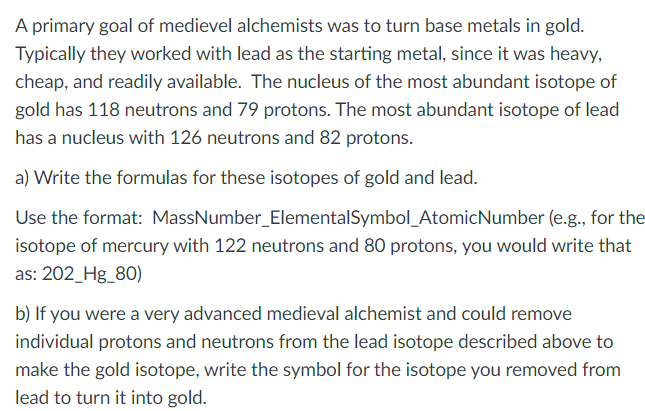A primary goal of medievel alchemists was to turn base metals in gold. Typically they worked with lead as the starting metal, since it was heavy, cheap, and readily available. The nucleus of the most abundant isotope of gold has 118 neutrons and 79 protons. The most abundant isotope of lead has a nucleus with 126 neutrons and 82 protons. a) Write the formulas for these isotopes of gold and lead. Use the format: MassNumber_ElementalSymbol_AtomicNumber (e.g., for the isotope of mercury with 122 neutrons and 80 protons, you would write that as: 202_Hg_80) b) If you were a very advanced medieval alchemist and could remove individual protons and neutrons from the lead isotope described above to make the gold isotope, write the symbol for the isotope you removed from lead to turn it into gold.
A primary goal of medievel alchemists was to turn base metals in gold. Typically they worked with lead as the starting metal, since it was heavy, cheap, and readily available. The nucleus of the most abundant isotope of gold has 118 neutrons and 79 protons. The most abundant isotope of lead has a nucleus with 126 neutrons and 82 protons. a) Write the formulas for these isotopes of gold and lead. Use the format: MassNumber_ElementalSymbol_AtomicNumber (e.g., for the isotope of mercury with 122 neutrons and 80 protons, you would write that as: 202_Hg_80) b) If you were a very advanced medieval alchemist and could remove individual protons and neutrons from the lead isotope described above to make the gold isotope, write the symbol for the isotope you removed from lead to turn it into gold.
Chemistry by OpenStax (2015-05-04)
1st Edition
ISBN:9781938168390
Author:Klaus Theopold, Richard H Langley, Paul Flowers, William R. Robinson, Mark Blaser
Publisher:Klaus Theopold, Richard H Langley, Paul Flowers, William R. Robinson, Mark Blaser
Chapter2: Atoms, Molecules, And Ions
Section: Chapter Questions
Problem 25E: The average atomic masses of some elements may vary, depending upon the sources of their ores....
Related questions
Question
100%

Transcribed Image Text:A primary goal of medievel alchemists was to turn base metals in gold.
Typically they worked with lead as the starting metal, since it was heavy,
cheap, and readily available. The nucleus of the most abundant isotope of
gold has 118 neutrons and 79 protons. The most abundant isotope of lead
has a nucleus with 126 neutrons and 82 protons.
a) Write the formulas for these isotopes of gold and lead.
Use the format: MassNumber_ElementalSymbol_AtomicNumber (e.g., for the
isotope of mercury with 122 neutrons and 80 protons, you would write that
as: 202_Hg_80)
b) If you were a very advanced medieval alchemist and could remove
individual protons and neutrons from the lead isotope described above to
make the gold isotope, write the symbol for the isotope you removed from
lead to turn it into gold.
Expert Solution
This question has been solved!
Explore an expertly crafted, step-by-step solution for a thorough understanding of key concepts.
This is a popular solution!
Trending now
This is a popular solution!
Step by step
Solved in 3 steps

Knowledge Booster
Learn more about
Need a deep-dive on the concept behind this application? Look no further. Learn more about this topic, chemistry and related others by exploring similar questions and additional content below.Recommended textbooks for you

Chemistry by OpenStax (2015-05-04)
Chemistry
ISBN:
9781938168390
Author:
Klaus Theopold, Richard H Langley, Paul Flowers, William R. Robinson, Mark Blaser
Publisher:
OpenStax

Living By Chemistry: First Edition Textbook
Chemistry
ISBN:
9781559539418
Author:
Angelica Stacy
Publisher:
MAC HIGHER

Chemistry: Principles and Practice
Chemistry
ISBN:
9780534420123
Author:
Daniel L. Reger, Scott R. Goode, David W. Ball, Edward Mercer
Publisher:
Cengage Learning

Chemistry by OpenStax (2015-05-04)
Chemistry
ISBN:
9781938168390
Author:
Klaus Theopold, Richard H Langley, Paul Flowers, William R. Robinson, Mark Blaser
Publisher:
OpenStax

Living By Chemistry: First Edition Textbook
Chemistry
ISBN:
9781559539418
Author:
Angelica Stacy
Publisher:
MAC HIGHER

Chemistry: Principles and Practice
Chemistry
ISBN:
9780534420123
Author:
Daniel L. Reger, Scott R. Goode, David W. Ball, Edward Mercer
Publisher:
Cengage Learning

World of Chemistry, 3rd edition
Chemistry
ISBN:
9781133109655
Author:
Steven S. Zumdahl, Susan L. Zumdahl, Donald J. DeCoste
Publisher:
Brooks / Cole / Cengage Learning


Chemistry
Chemistry
ISBN:
9781305957404
Author:
Steven S. Zumdahl, Susan A. Zumdahl, Donald J. DeCoste
Publisher:
Cengage Learning